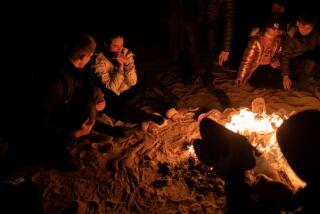India and China in a tit-for-tat spat
In the latest chapter of a simmering spat with China involving border disputes, long-standing mistrust and domestic electoral politics, India’s Foreign Ministry on Wednesday called on Beijing to halt work on all projects in Pakistani-controlled Kashmir.
The demand followed an announcement Tuesday by the leaders of China and Pakistan that their nations would upgrade a cross-border highway and that China would lend full support to a hydroelectric venture. Both projects are in the Pakistani-controlled portion of Kashmir, which India claims.
India and China have eyed each other warily since at least 1962, when they fought a monthlong border war that the Chinese in effect won. China has long been allied with Pakistan, which in turn has fought three major wars with India over the last six decades.
The latest Indian salvo at Beijing followed a protest Tuesday by China after India’s prime minister visited the northeastern state of Arunachal Pradesh, portions of which Beijing claims, and allegations that Chinese troops fired into India and crossed the border, leaving “China” painted in red ink on rock faces.
China has begun to issue visas -- on paper separate from their passports -- to Indian citizens from Arunachal Pradesh and disputed Jammu and Kashmir, perhaps suggesting that the states are not really part of India. New Delhi has threatened to tighten visa rules for Chinese working in India and to discontinue granting them business visas in favor of the more restrictive work visas.
The Chinese construction projects and Indian Prime Minister Manmohan Singh’s visit to Arunachal Pradesh were anticipated and hardly surprising. In fact, given that there are mechanisms in place to address border disputes, the protests may be a bit of posturing on both sides for domestic consumption, analysts said.
“I don’t think it will have any long-term impact,” said Rukmani Gupta, a research fellow at the Institute of Peace and Conflict Studies in New Delhi. “Still, these escalating protests are hardly conducive to the dialogue process.”
Singh’s visit had nothing to do with territory but a lot to do with the prime minister shoring up his governing Congress Party’s position leading up to elections early this week in Arunachal Pradesh and two other states; the results are expected by the end of the month.
“Congress has to keep winning state elections; there’s no international objectives,” said R. Hariharan, a retired military intelligence specialist. “They [the Chinese] don’t really understand that on the other side. They have no elections.”
The two nations have conducted 13 rounds of talks over three decades to try to resolve their border disputes. These stem in part from the 1962 war but more fundamentally from demarcations made during the British Empire that India recognizes and China does not.
Another factor in the recent rise in tensions, say analysts, is the Dalai Lama, the exiled Tibetan spiritual leader, who lives in northern India. He plans to visit next month an Arunachal Pradesh site revered by Tibetan Buddhists.
Beijing is deeply suspicious of the Dalai Lama, particularly after deadly protests erupted in March 2008 among ethnic Tibetans across China’s Tibetan plateau.
“The Chinese have always been very touchy on things like the Dalai Lama,” said K. Shankar Bajpai, a former Indian ambassador to China and now chairman of the Delhi Policy Group think tank. “We see our support for him as an act of kindness to a refugee. They view it as our trying to use him as an instrument of policy, which is not true. There’s a tendency there to see the world as you view it.”
In recent years, China has worked hard to settle lingering border disputes with Russia and other neighbors to better focus on domestic growth and stability. However, there’s been little progress along the 2,100-mile border with India.
In part this is a reflection of geography, some observers said. Because the Chinese-Russian border is largely uninhabited, the two sides were able in many cases to split the difference. The disputed Indian border regions have populated communities, infrastructure and Indian voters.
Despite their differences, the neighbors have sought to build confidence. Last year, senior Indian military officers visited Tibet and the Chinese city of Chengdu. And two-way trade has grown more than 20% annually and is expected to reach $60 billion next year, a thirtyfold increase since 2000, although it’s weighted heavily in China’s favor.
“This is all a bit of a power play,” Hariharan said. “The issues can’t be resolved in the short term.”
--
Anshul Rana in The Times’ New Delhi Bureau contributed to this report.
More to Read
Start your day right
Sign up for Essential California for news, features and recommendations from the L.A. Times and beyond in your inbox six days a week.
You may occasionally receive promotional content from the Los Angeles Times.






